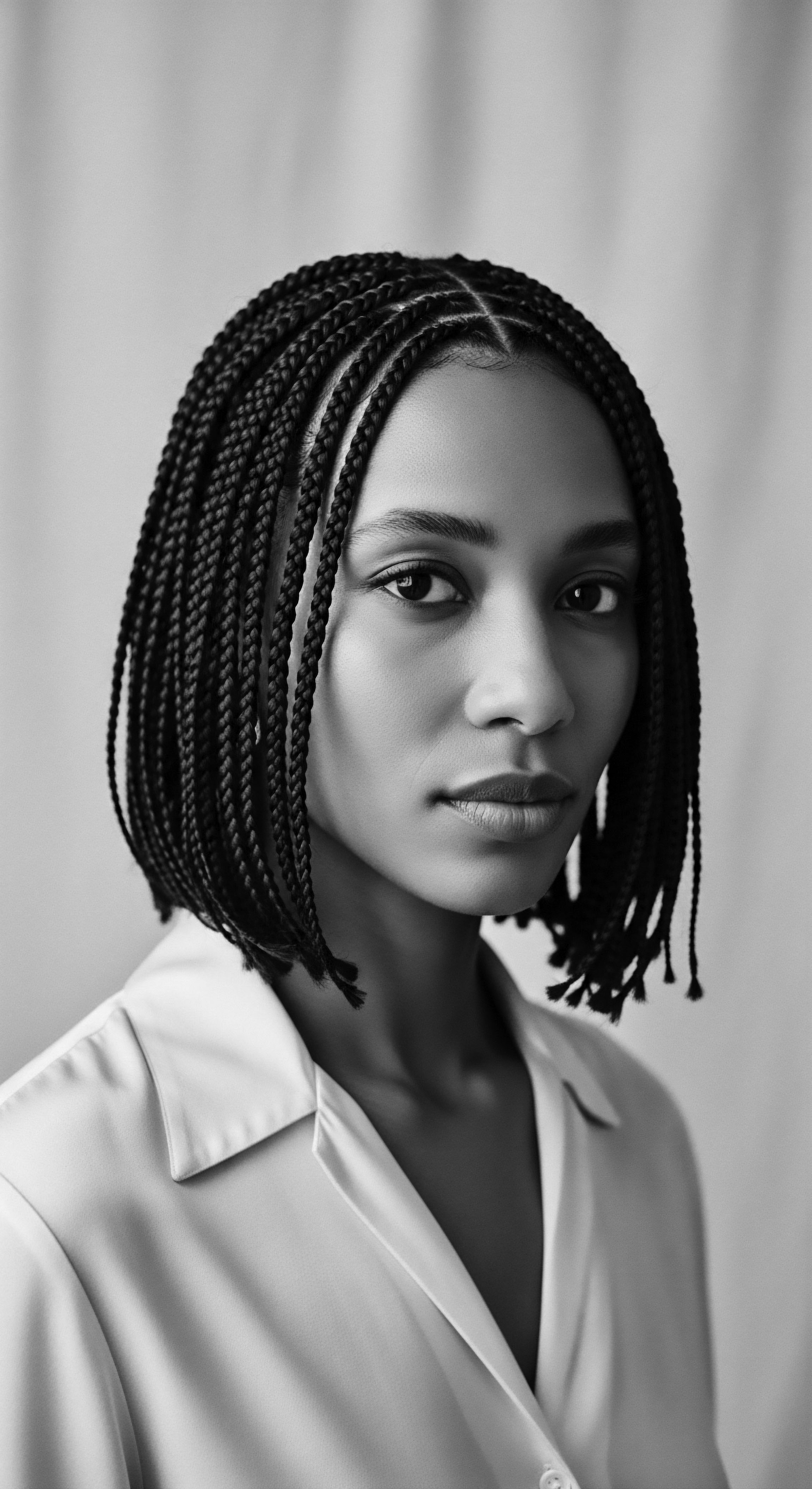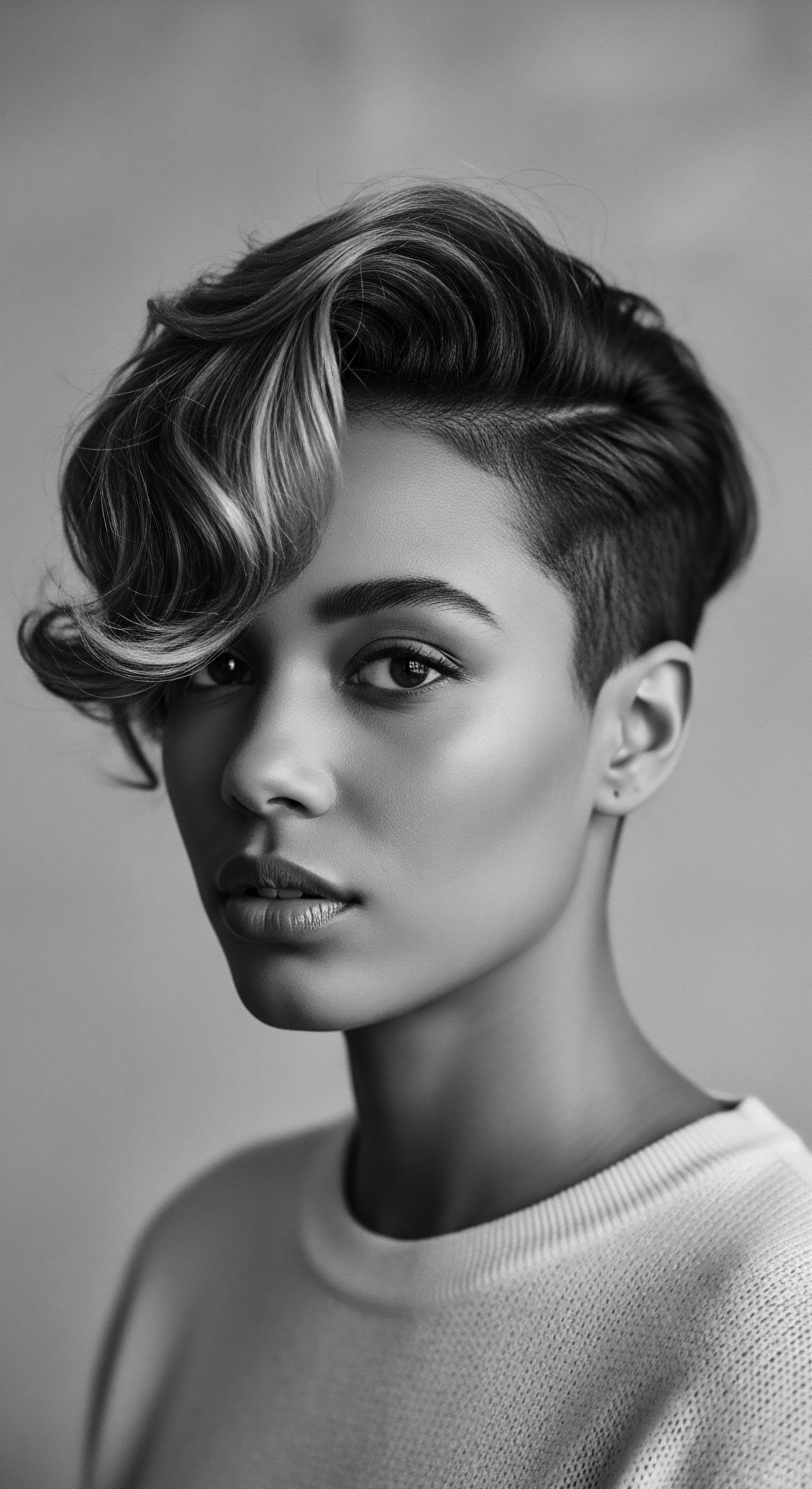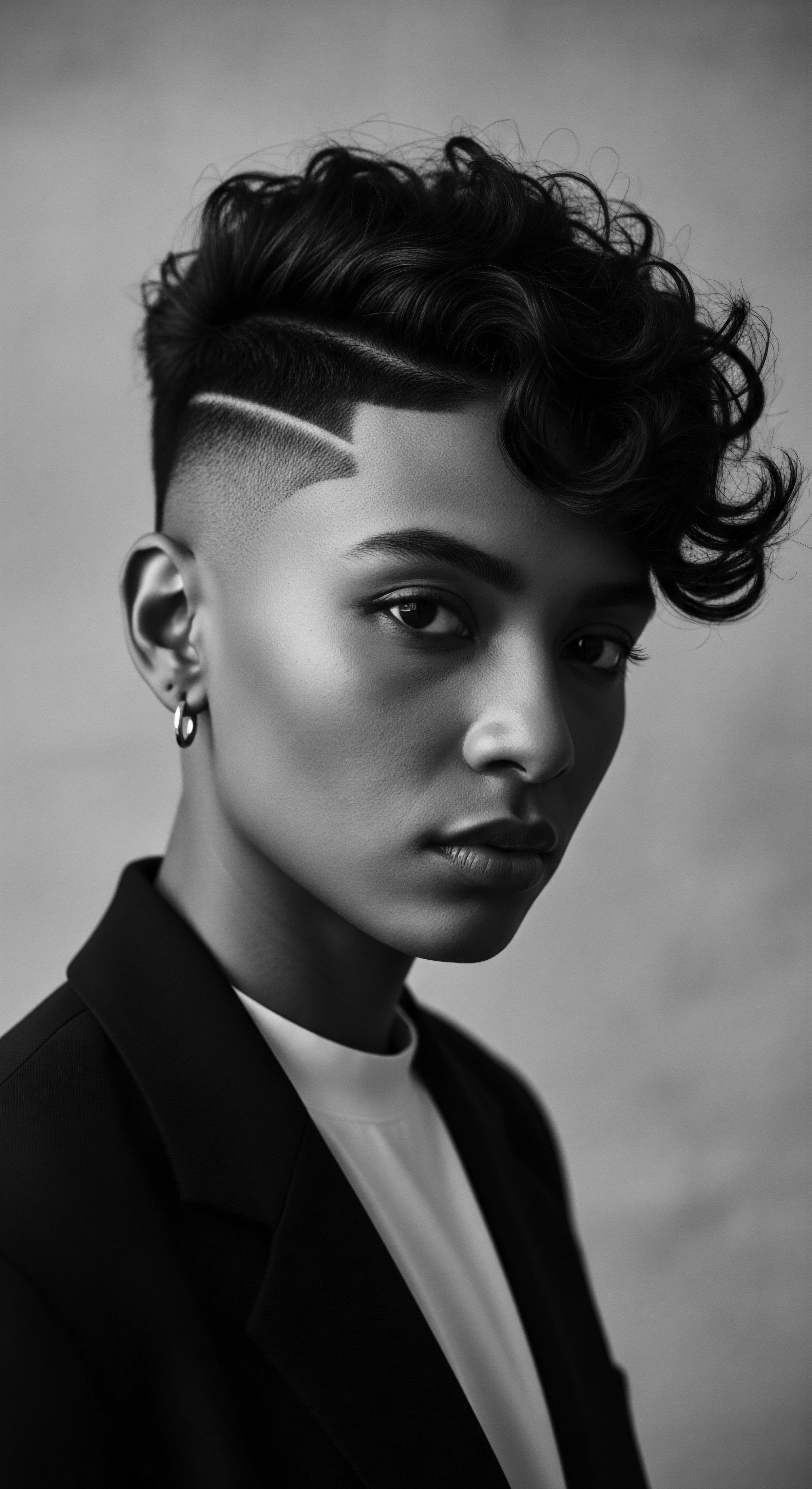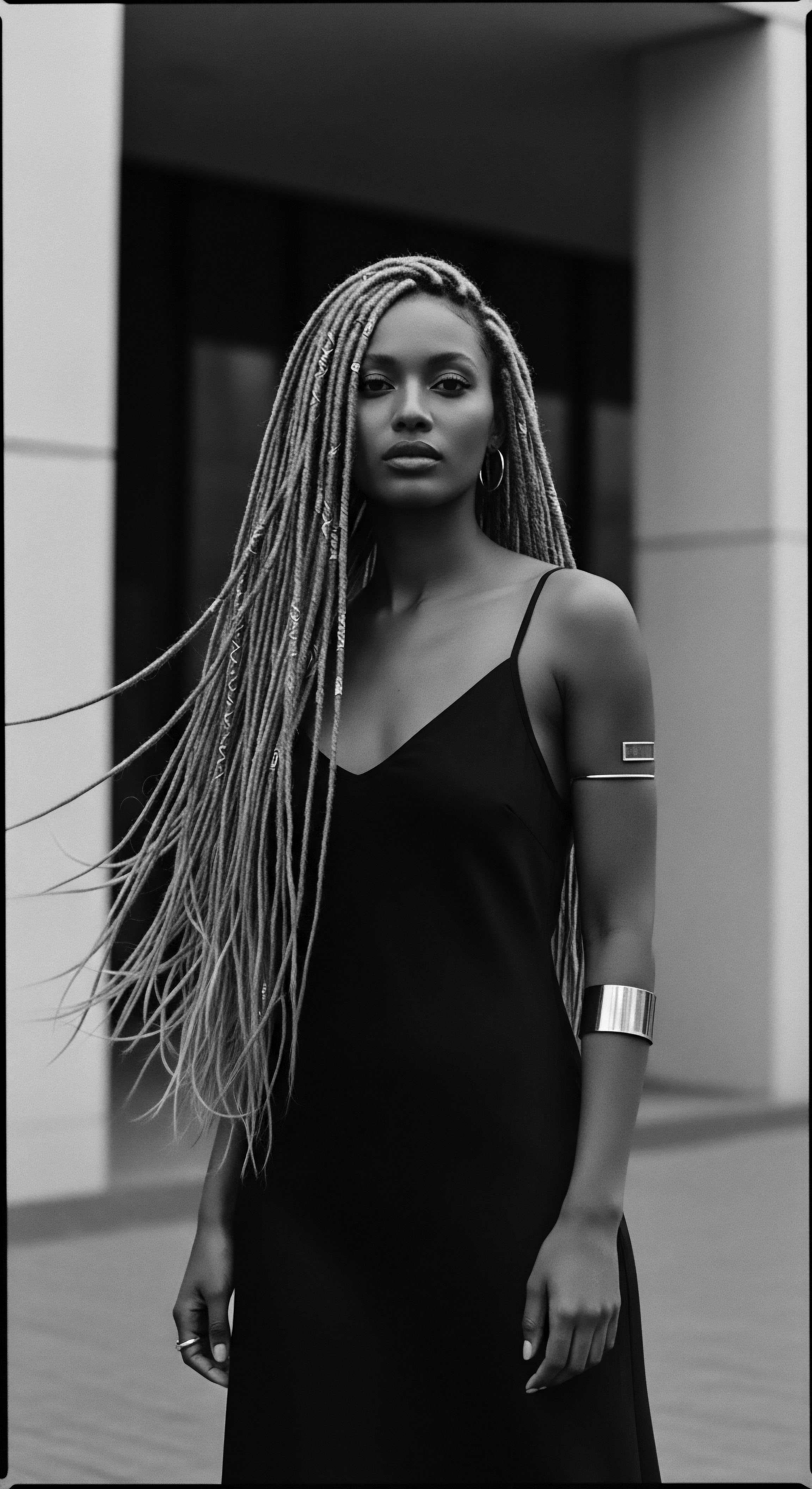
Roots
Feel the subtle hum, a whisper carried on ancestral breezes, speaking of strands that stretch not just from scalp to tip, but through generations, across continents, and into the very core of identity. This is the truth of textured hair, a living archive, each curl, coil, and wave holding tales from time immemorial. Before the laboratories and the modern marketing, before the global beauty industry, there existed a profound understanding of hair’s vitality within African civilizations. This understanding, rooted in observation and reverence, forms the bedrock of our present-day connection to hair wellness.
To truly grasp how ancient African techniques inform contemporary textured hair styling and wellness, one must first recognize hair not as a mere aesthetic accessory, but as a biological marvel imbued with cultural significance. The very structure of textured hair, with its unique elliptical shape, tighter cuticle layers, and varied curl patterns, presented both opportunities and challenges that necessitated ingenious care methods across diverse African societies. These societies, spanning vast geographies and millennia, developed sophisticated approaches to hair anatomy and its preservation, often intertwined with spiritual beliefs and social standing.

Hair Anatomy and Ancestral Sight
Our current scientific grasp of textured hair’s microscopic architecture, with its unique helical structure and tendency towards fragility at points of curvature, often parallels the practical wisdom held by ancient African communities. They may not have possessed electron microscopes, yet their meticulous care rituals suggest an intuitive comprehension of hair’s needs. Consider the Bantu knot, for instance, a style observed in various forms across the continent. Its inherent design minimizes manipulation, protects hair ends, and creates definition, a testament to an understanding of preventing breakage and encouraging growth.
This ancestral ingenuity showcases an early, empirical science of hair mechanics. The observation of how hair behaved, how it responded to certain plant compounds, natural fats, and even the elements, built a collective body of knowledge passed down through oral tradition and practical demonstration.
Within many ancient African societies, hair’s condition was seen as a reflection of inner wellbeing, directly linking physical vitality to spiritual and communal health. The very act of hair care was often a communal affair, particularly among women, solidifying bonds and transmitting knowledge. This holistic view, where the physical aspects of hair were inseparable from its spiritual and social dimensions, established a foundational principle that continues to resonate with contemporary wellness movements that seek to harmonize body, mind, and spirit.

The Language of Curls and Coils
Modern textured hair classification systems, while useful for product formulation, often fall short in capturing the spectrum of ancestral understanding. In ancient African contexts, hair classification was not based on a numerical chart but on social status, marital state, age, tribal affiliation, and spiritual role. A woman’s intricate braided patterns, for example, might communicate her eligibility for marriage, her lineage, or her social standing within her community. A warrior’s dreadlocks could signify strength and spiritual connection.
These were classifications based on meaning, not just morphology. The styles were living symbols, each thread telling a story, each braid a declaration.
The traditional lexicon for hair varied immensely across linguistic groups but often centered on descriptive terms for hair’s natural state, the tools used for its creation, and the social significance of the resulting styles. While we now speak of ‘type 4C’ coils or ‘3A’ waves, ancient African communities employed terms that spoke to the hair’s resemblance to natural phenomena, its texture, or its cultural function. For instance, some languages might have specific terms for hair styled to mimic a ram’s horn, or hair that indicated a journey. This deep cultural vocabulary highlights a heritage where hair was an active participant in communication and identity.

Growth Cycles and Elemental Wisdom
The human hair growth cycle—anagen, catagen, and telogen phases—was perhaps not explicitly understood in ancient times, yet practices aligned with promoting prolonged anagen (growth) and minimizing telogen (resting) phases. Consider the frequent use of scalp massage with natural oils and butters, a practice widespread across various African regions. This gentle stimulation likely improved blood circulation to the hair follicles, providing necessary nutrients for robust growth. Furthermore, the selection of specific plant-based ingredients often possessed properties now recognized for their anti-inflammatory or antimicrobial benefits, creating a healthier scalp environment conducive to sustained growth.
Ancient African communities intuitively understood hair vitality, weaving physical care with profound cultural and spiritual meaning.
Environmental factors, such as the intense sun, dry winds, or humid conditions prevalent in different African climates, also shaped hair care practices. Hair was often protected from the elements through elaborate styling, head coverings, or the application of natural coatings like red ochre mixed with animal fats, as seen among the Himba people. This protective layer not only guarded against environmental damage but also served as a cosmetic and symbolic adornment. Their practices offer a glimpse into how ancestral methods safeguarded hair, maintaining its integrity despite harsh conditions.
The deep lineage of knowledge, spanning millennia, forms the very ‘roots’ of contemporary textured hair care. These ancient insights, born of observation and a profound connection to the land and spirit, laid the foundation for the complex and reverent practices we witness and adapt today.

Ritual
The hands move with practiced rhythm, a dance passed through generations, transforming strands into statements. This is the essence of ritual in textured hair styling, a continuation of practices born on the African continent, refined through centuries, and echoing in every contemporary braid, twist, and loc. The art of styling textured hair in ancient Africa transcended mere aesthetics; it was a powerful medium of cultural expression, social stratification, and personal agency. These traditions, meticulously observed and transmitted, form the ‘ritual’ of our hair heritage, a living legacy that sculpts identity and preserves communal memory.

Protective Styling’s Ancestral Roots
Many of the protective styles celebrated today trace their lineage directly to ancient African kingdoms and communities. Styles like cornrows, box braids, and various forms of twisting were not simply fashionable; they were functional, designed to protect hair from environmental damage, reduce manipulation, and encourage length retention. Historical records and archaeological finds from across Africa reveal the widespread existence of these techniques.
For example, the intricate braided styles depicted on ancient Egyptian tomb paintings and sculptures, or the elaborate coiffures of West African royalty, were often protective in nature, incorporating extensions and adornments that symbolized status and spiritual connections. The longevity of these styles, sometimes worn for weeks, speaks to their efficacy in preserving hair health while conveying complex messages within society.
- Adornments ❉ Shells, beads, gold, and other precious materials were woven into protective styles, signifying wealth, tribal affiliation, or spiritual beliefs.
- Preparation ❉ Hair was often cleaned and conditioned with natural oils and butters before braiding, ensuring flexibility and minimizing friction.
- Longevity ❉ Styles were designed to last, protecting hair during long journeys, agricultural seasons, or ritual periods, showcasing practical innovation.

How Does Ancient Adornment Influence Modern Beauty?
The practice of adorning hair, seen vividly in ancient African cultures, also profoundly shapes modern textured hair styling. Beyond protective elements, hair was a canvas for intricate adornment. The Dogon people of Mali, for instance, used intricate braids and coiffures adorned with cowrie shells and amber beads, each element carrying symbolic weight.
In ancient Egypt, wigs made from human hair, wool, or vegetable fibers were not only signs of wealth and status but also served practical purposes like sun protection and hygiene. These wigs were styled in various ways, often mimicking popular natural hairstyles of the time, and were meticulously cared for.
Today, the widespread use of hair extensions, wigs, and elaborate hair jewelry in textured hair styling mirrors these ancestral inclinations. While contemporary trends might be driven by fashion, the underlying impulse to adorn, protect, and transform hair through added elements carries a historical echo. The artistry involved in custom wig creation or the careful placement of beads and cuffs in braids today speaks to a continuity of aesthetic and cultural practices that have always seen hair as a powerful tool for self-expression and connection to heritage.

The Original Toolkit for Textured Hair?
The tools employed in ancient African hair care were simple yet remarkably effective, embodying an ingenuity born of necessity and deep material knowledge. Early combs, carved from wood, bone, or ivory, often featured wide teeth suitable for detangling dense, coily hair without causing damage. These combs were frequently works of art themselves, often adorned with symbolic carvings.
Other tools included sharpened sticks for parting hair, and various containers for mixing and storing natural concoctions of oils, herbs, and clays. The use of natural fibers for extensions, like raffia or sisal, highlights an understanding of how to augment hair’s volume and length with readily available resources.
From ancient braids to modern adornments, the artistry of African hair styling remains a vibrant, evolving tradition.
This historical toolkit stands in contrast to the specialized, often plastic and metal tools of modern styling, yet the principles of gentle detangling, precise parting, and protective extension application persist. The enduring legacy of these ancient tools is found in the continued preference for wide-tooth combs, the return to natural, biodegradable materials in some products, and the ongoing appreciation for handmade hair accessories that carry cultural significance.
| Ancient Tool Wide-tooth wooden comb |
| Traditional Use Detangling, parting, stimulating the scalp with natural oils. |
| Contemporary Parallel/Influence Modern wide-tooth combs and shower combs for gentle detangling on wet hair. |
| Ancient Tool Gourd or clay mixing bowl |
| Traditional Use Preparing herbal rinses, natural masks, and oil blends. |
| Contemporary Parallel/Influence Ceramic or glass bowls for DIY hair treatments, emphasizing natural ingredients. |
| Ancient Tool Bone or ivory pick/parting stick |
| Traditional Use Creating precise sections for intricate braiding and styling. |
| Contemporary Parallel/Influence Styling combs with long, thin tails for precise parting and sectioning. |
| Ancient Tool These comparisons illustrate how ancestral tools, born from necessity and a deep understanding of textured hair, set precedents for today's essential hair care implements. |
The historical journey of textured hair styling is not a linear progression but a spiral, returning to foundational principles while adapting to new contexts. The ‘ritual’ of hair care, in its deepest sense, embodies this enduring connection between ancient ingenuity and contemporary practice, ensuring that the legacy of African hair artistry continues to inspire and define generations.

Relay
The baton passes from ancient hands to contemporary stylists, carrying with it not just techniques, but a philosophy of holistic wellbeing and resilience. This transfer, this ‘relay’ of wisdom, reveals how deeply ingrained ancestral practices are in the pursuit of radiant textured hair today. Beyond styling, the daily rhythms of care, the remedies for common concerns, and the understanding of hair as a spiritual and physical barometer find their genesis in the cumulative knowledge of African foremothers. This section analyzes the complexities of how ancient African techniques inform contemporary textured hair styling and wellness from multiple perspectives, considering the interplay of historical studies, ethnographic data, and scientific understanding.

Building Regimens from Ancestral Wisdom?
Personalized textured hair regimens, a staple of modern wellness, draw significant inspiration from ancestral practices that were inherently tailored to individual needs and local resources. Ancient African communities did not follow a single, universal regimen. Instead, practices varied widely based on climate, available flora, social status, and personal preference. The emphasis was on maintaining scalp health, protecting strands, and nourishing hair from root to tip using locally sourced ingredients.
For instance, in parts of West Africa, shea butter (Butyrospermum parkii) was a foundational element, prized for its moisturizing and protective qualities, often applied to hair and scalp to prevent dryness and breakage (Agyepong, 2012, p. 78). This approach, emphasizing adaptability and the intelligent utilization of natural compounds, is directly reflected in contemporary wellness circles that advocate for personalized product selection and ingredient awareness.
The systematic approach to hair care—cleaning, conditioning, detangling, and protecting—was not formalized into ‘steps’ as we know them, but the underlying principles were ever-present. Herbal infusions for cleansing, oiling rituals for conditioning and sheen, and protective styles for preservation were all components of an unspoken regimen, a daily dance of care that secured hair’s vitality. This continuity from communal historical traditions to individualized modern routines highlights a powerful legacy of self-care and preservation.

The Nighttime Sanctuary’s Historical Echoes
The practice of protecting hair at night, often with bonnets, scarves, or specific sleeping arrangements, is a wisdom directly inherited from ancient African traditions. While the exact historical context for head coverings during sleep is less explicitly documented than daytime adornment, the necessity of protecting elaborate hairstyles and delicate strands from friction and environmental pollutants would have been paramount. In many African cultures, head coverings, whether for daily wear or specific occasions, held deep cultural and symbolic meaning. For example, in some West African societies, the way a headwrap was tied could indicate social status or marital standing.
The extension of this protective philosophy to nighttime care represents a practical application of a broader cultural understanding of head and hair sanctity. This tradition, emphasizing the preservation of style and health through the night, directly informs the ubiquitous use of silk and satin bonnets, scarves, and pillowcases today.
Ancestral ingenuity in hair care, from plant-based balms to protective head coverings, continues to shape contemporary wellness.
The selection of materials for these coverings often mirrored the desire for breathability and minimal absorption of hair’s natural moisture. While modern options include engineered fabrics, the foundational idea of using smooth, non-absorbent materials to prevent dryness and frizz was likely an empirical discovery made by ancient practitioners observing the effects of various fabrics on hair integrity.

Connecting Hair Wellness to Ancient Wellness Philosophy
Ancient African wellness philosophies often viewed the individual as an interconnected part of a larger cosmos, where physical health was inseparable from mental, spiritual, and communal harmony. Hair, being a highly visible and symbolic part of the body, played a significant role in this holistic framework. For instance, in many traditions, hair was seen as a conduit to the divine or a receiver of spiritual energy.
The careful tending of hair was therefore not just a physical act but a spiritual practice, a form of reverence for one’s lineage and connection to the world around them. This perspective is a potent counterpoint to the often fragmented approach of Western medicine, which tends to separate bodily systems.
Consider the anecdotal evidence from ethnobotanical studies that highlight the widespread use of plants like Aloe Vera or various tree barks for both internal healing and external hair care in many traditional African societies. The same plant used to soothe digestive issues might also be applied as a hair mask, underscoring a unified approach to wellness. This holistic perspective encourages a deeper understanding of textured hair wellness, moving beyond topical solutions to address nutritional intake, stress levels, and even emotional wellbeing as contributing factors to hair health. The contemporary movement towards ‘mindful’ beauty and self-care, often seen within textured hair communities, directly echoes these ancestral philosophies, recognizing that truly vibrant hair springs from a balanced inner landscape.
The ‘relay’ of these practices underscores a continuous conversation between past and present, a dynamic exchange where ancient knowledge is reinterpreted through modern understanding, enriching the global dialogue on textured hair care and wellness. This transmission ensures that the ingenuity and reverence of those who came before us continue to shape the vibrant future of textured hair.

Reflection
The journey through ancient African techniques that inform contemporary textured hair styling and wellness leaves us at a powerful juncture ❉ the recognition that our hair, in its myriad forms, is a living legacy. It is a profound meditation on textured hair’s heritage and its care, a vibrant, breathing archive etched into every strand. The echoes from the source, the tender thread of community care, and the unbound helix of identity all speak to a lineage of wisdom that transcends time.
To engage with textured hair today is to participate in an enduring conversation with ancestral hands, with ancient forests, and with the resilient spirits of those who first understood hair’s profound connection to self and community. The ingenuity of African civilizations laid down the foundational principles of care, protection, and adornment, principles that, though perhaps re-contextualized by modern science and global commerce, remain undeniably rooted in the profound heritage of Black and mixed-race experiences. Our hair, then, becomes more than just fibers; it is a repository of history, a canvas of culture, and a declaration of continuity. In each gentle detangling, each protective style, each natural ingredient chosen with care, we honor a heritage that continues to shape and elevate our understanding of wellness, beauty, and identity.

References
- Agyepong, G. (2012). The Science of Black Hair ❉ A Comprehensive Guide to Textured Hair Care. GHC Publishing.
- Ayad, M. F. (2009). Hair and the Human in Ancient Egypt. Oxford University Press.
- Fletcher, J. (2001). Hair in Ancient Egypt ❉ An Overview. In J. R. Ogden (Ed.), Ancient Egyptian Materials and Technology. Cambridge University Press.
- Ogunsina, S. A. (2018). African Traditional Hairdressing ❉ Styles, Significance, and Survival. University of Ibadan Press.
- Roberts, N. (1995). The Art of African Textiles ❉ Technology, Tradition, and Lure. The Art Institute of Chicago.
- Sachs, W. (1937). Black Hamlet. Wits University Press. (This provides historical context for traditional practices and societal views on hair).
- Thompson, R. F. (1993). Flash of the Spirit ❉ African and Afro-American Art and Philosophy. Vintage Books.
